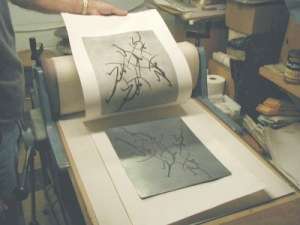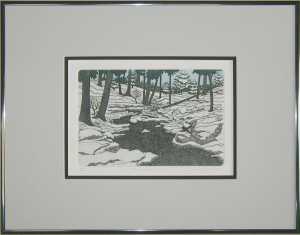The Intaglio Process
Creating the Image
Each hand-pulled etching is individually taken from a zinc plate that is crafted by the artist. To begin this process, the artist starts with a pencil detail of the image. Using a white chalk pencil, he coats the back of the drawing and then places the paper on top of the zinc plate, which has been entirely covered with a black resist covering. Next, using a sharp steel stylus, the artist etches the line, exposing the shiny metal of the plate below.
The plate is then submerged in a special acid solution, which bites the image into the zinc surface. The acid can only bite the plate in the areas where the protective ground has been removed, thus etching the desired image into the metal. This part of the process may take several days to several weeks, depending on the intricacy of the image involved.
To print the image, the plate is entirely covered with a thick, oil-based ink. The ink is then wiped off of the plate, leaving only a thin trace of the substance buried in the etched lines of the metal. This wiping of the plate lends each impression a slightly different texture, leaving some areas having a richer tonal value than others.
A museum-quality, 100% rag cotton-fiber paper is then soaked in a water bath for about 15 minutes, before beeing blotted to a semi-wet state. The artist then places the cotton paper on top of the etched, inked plate using wooden tongs (for his hands are covered in ink), being sure to carefully line up the edges of the paper with those of the plate. Three different thicknesses of felts are then placed on top of the paper, and the image is sent through a star-wheeled hand-press. At this point, the artist is in complete control of the pressure and speed at which the plate is run through.
Next, the artist removes the felts, then slowly pulls the cotton-fiber paper off the plate without blurring or shaking the still-wet impression. After the etching is set to dry on a rack, it is hand water-colored to enhance the visual aspect. Each is then matted by the artist with museum board, for maximum conservation purposes.

The zinc etching plate
|

Hand-pulling the etching
|
Matting & Presentation
Arches & Rives Paper

The Library of Congress sets the following standards of conservation for museum (permanent) matboard:
- It must be made of lignin free pulp (either 100% alpha cellulose or 100% cotton rag are acceptable).
- It must have an alkaline pH with a buffer reserve.
- Its colors must be both fade and bleed resistant.
- The matboard must be totally free from contamination and impurities.